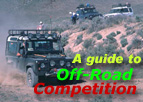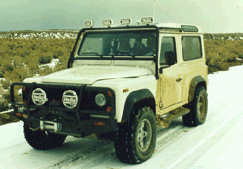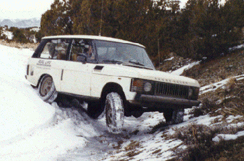|
Welcome to ORE! |
|
||
|
|
|||
|
|
|||

|
26) Tires or Tyres... There are so many different types of tires available now days that choosing the correct one for you and your vehicle may get a bit confusing. Consider where you live (snow belt or sunny California). Think of your primary use first, then consider how much off-roading you really do. If you’re commuting everyday, you really don’t need Mud T/A’s. Don’t over-tire your vehicle either. Always remember that all wheels, including the spare must be of the same type, size and make. If your vehicle is equipped with a space-saver spare, get rid of it immediately. These so-called spares are more trouble than they are worth, in most cases all but useless. If you’re off-road, or worse, chained up, and you have a flat, now what? If you’re chained?... Let’s say your right-rear tire is flat, you’ll first have to jack up the front and fit the space-saver, then transfer the proper wheel/tire to the right-rear, where the chains can then be refitted. A lot of work. If you didn’t do so, and fitted the space-saver on the right-rear, you’ll quickly find out that the chains do not fit. With only one wheel chained you’ll go nowhere. When off-road, you will now have a tire smaller than the others, which isn’t good for the axles and transfercase gears (this applies to any spare tire not of the same size as those fitted to the vehicle), nor is it very helpful when traction maybe needed to get back to pavement. A number of tires, though marked "M&S", are not legal by CHP or Cal-Trans standards, so beware! On a recent trip we spotted a number of 4wd suv’s chained up while crossing Donner Pass, this was due to the type of tires fitted, i.e.; road bias type. This is something we don’t understand. A number of 4wd owners (and dealers) have a nasty habit of fitting overly large tires to their 4wd’s. It may look good, but chances are it has a number of draw backs. The larger the increase in tire diameter, the more the final drive gear ratio is effected, as is performance. Large tires also effect hub bearings, steering, as well as suspension and ride, the latter two relate to excessive un-sprung weight on the axles. Finally, the speedometer will no longer read correctly. Today’s electronic speed-o’s are nearly impossible to re-calibrate. When considering changing the tires size and rim width/dia, check with a real expert, one that will give you the complete story (beware of those just trying to make a sale). As already stated elsewhere, tire pressures can be adjusted to increase traction (and improve ride), but they must be re-inflated prior to road use, otherwise heat build up can cause tire damage and/or blowouts, handling will also be effected. Excessive tire pressure will give a poor ride and poor handling. Check your owners manual first, then tire manufacturer specifications. Do not blow the tires up to their maximum for general road & off-road work, it’s too high.
27) Snow chains... How many of you own them? How many have used them? Believe it or not, chains are not only a benefit in snow and ice, but can work wonders off-road as well. If in very slick mud conditions and forward progress is near nil, try fitting the chains (correct sizes with rubber or spring straps, not cable-chains!), you’ll be surprised. Which wheels do you fit them on? Normally on the rear, even more so when climbing up hill, or towing, as the weight transfers to the rear wheels, thus giving you maximum traction. In some cases it may be necessary to fit them to the front, or all four (4) wheels. Just because you own a 4WD, don’t think you’re immune to chaining up while in the mountains, you’re not.
28) Rocks, these can be tricky, and it’s almost an art, either of getting through, or smashing your car (ala Rubicon). We’re not "rock climbers" here at "ORE", and all Beginner & Intermediate courses avoid the rough areas (Advanced & 1-on-1 course may choose to go to such areas). When off-road however, you’ll always encounter rocks of some sort or another. Careful driving and spotting can help you avoid vehicle and wheel/tire damage (be careful with the sidewalls on your tires, rocks can tear them open). Survey the area chosen first. Walk it. Use your spotter as necessary. Find that path through. Drive slowly and with caution, remembering your ground clearance, approach/departure angles, plus your break-over clearance. If rocks are too large to put under your car, you’ll have to go around, or... over them. Be careful. Here’s another story we’d like to share with you. Daddy buys young son a new 4WD for graduation, $35K kind of money. One day vehicle arrives at our shop on a tow truck. With only 4000 miles on the clock it has four flat tires, four damaged rims, a bent front bush guard, rear lamp guards ripped off, the front axle bowed, and paint scratched to death. We asked what and where this had happened, the reply being "we were on the Rubicon!". "What part?", we asked. After a chat, it seems the young 4x4 driver had sped into a large rock field, not having a clue that he’d have to walk the vehicle up and over the immovable obstacles, the expensive damage was the end result of his lack of experience and knowledge. 29) Hill climbing, some think, is a sport in itself. When you see off-roaders rushing up a particular hill for the sole reason of getting to the top, you can be sure trouble isn’t too far behind. In most cases this is a useless sport, damaging the trails, and usually the vehicle (everything from broken axle shafts from excessive wheel spin, to roll overs). If you have to go up, refer to #14 & 18 for starters. Should your vehicle stall part way up, don’t panic! Quickly hold the brakes, engage reverse (re-start engine if needed) and release all pedals, letting the vehicle back down in gear via engine braking, stay off the brakes! With the engine now above you, and the weight shifted onto the rear axle, your vehicle is quite unstable and can go into roll-over-mode very easy. If... the front end begins to slide to one side, quick use of the throttle will straighten the vehicle out, as soon as its once again straight with the trail, release the throttle, DO NOT touch the brakes, as the front end will try to pass the rear when the weight shifts further. We’ve seen what happens to a number of these types of off-road wrecks, sometimes with nasty and deadly results. When coming down front first, engage low-range/first gear and then nose it over the edge. Let the engine and gearbox do all the work (engine braking). Don’t panic, try and stay off the brake pedal. If it starts sliding, touch the throttle enough to overcome (out run) the slide, then release the pedal once again letting the engine do its thing. Easy really. 30) Side slopes are another hazard of off-roading. Some vehicles can operate on a 45-degree side slope, but only with traction. Basically, try to avoid such dangerous situations when possible. 31) Don’t overload your vehicle. Keep in mind that loads should be distributed evenly within the vehicle if at all possible. Loads behind the rear axle will sag the rear of the vehicles, thus limiting departure angle/clearance. When a roof rack is fitted be extremely aware of weights and how they are distributed. Excessive loads will change the center-of-gravity, thus making the vehicle less stable. Also, beware of the additional height of the vehicle with the rack fitted. 32) Once clear of your off-road area it is most important that you check over your vehicle completely before commencing with your highway travel. It is important that the vehicle is checked over completely for leaks or brush hanging from the frame, or anything else that could prove hazardous to you and your vehicle or other drivers before commencing freeway speeds and travel. Be sure to check & inflate the tires. 33) A quick and brief reminder...
For more information concerning off-road accessories such as winches, hi-lift jacks, locking differentials, tires, lights, under vehicle protection, feel free to contact "ORE" anytime with your questions or purchasing requirements. |




